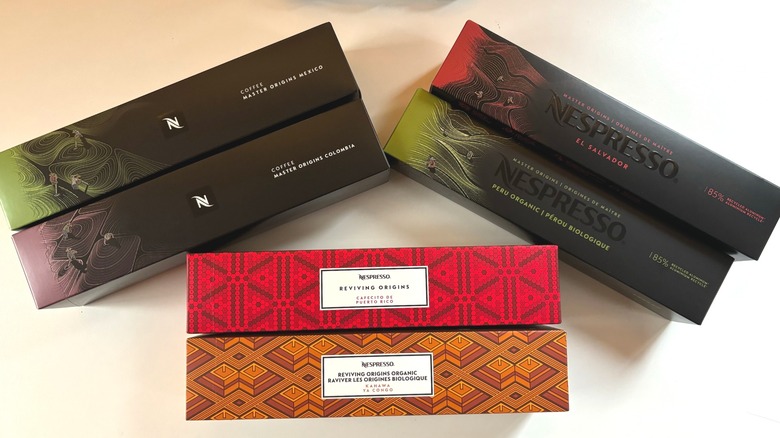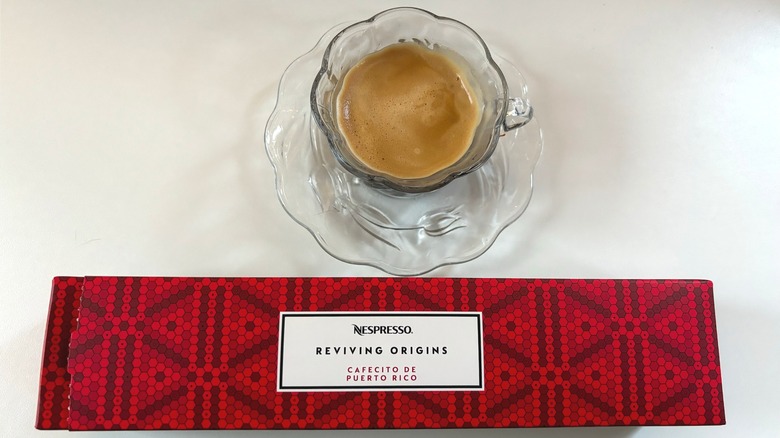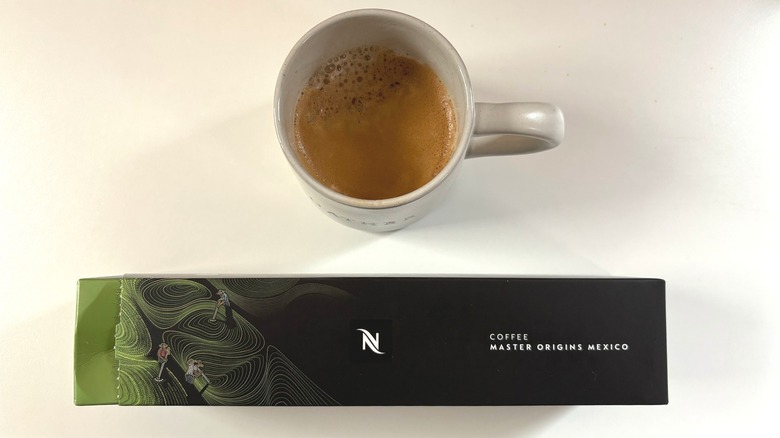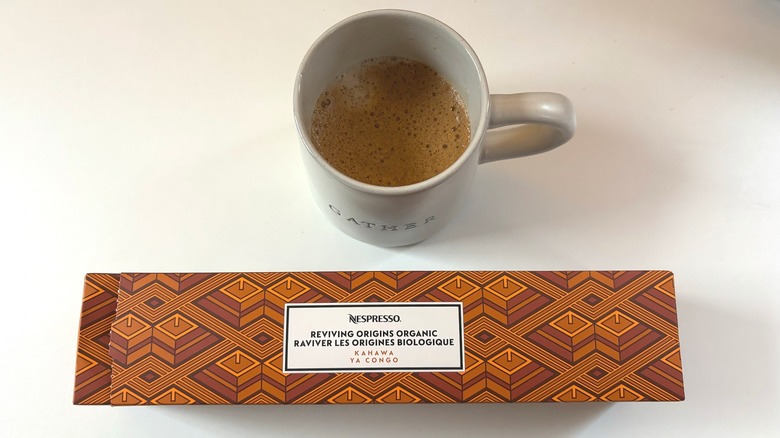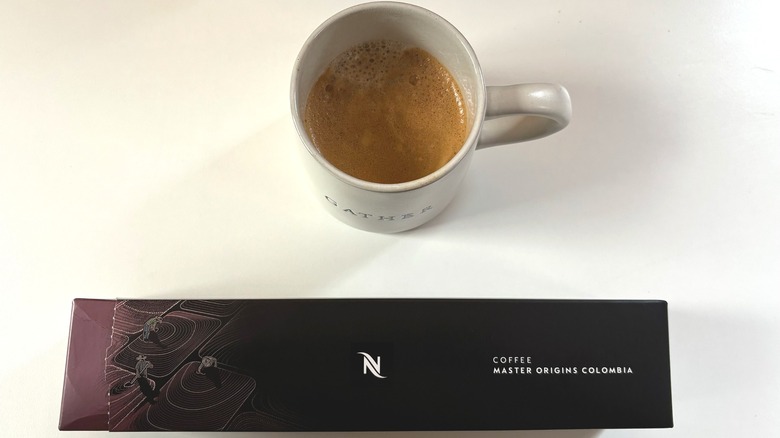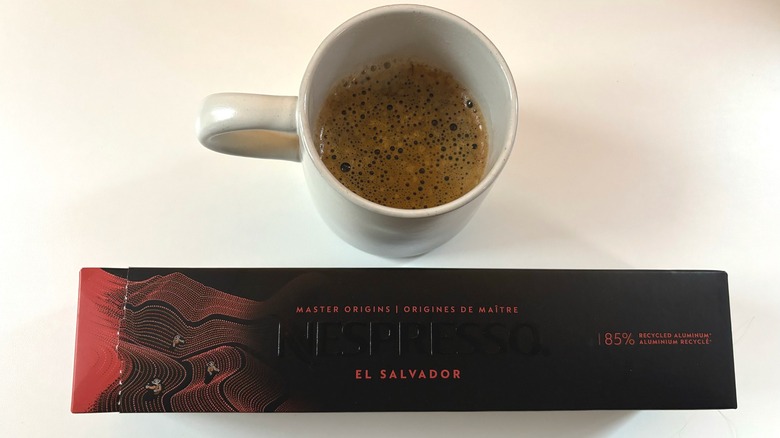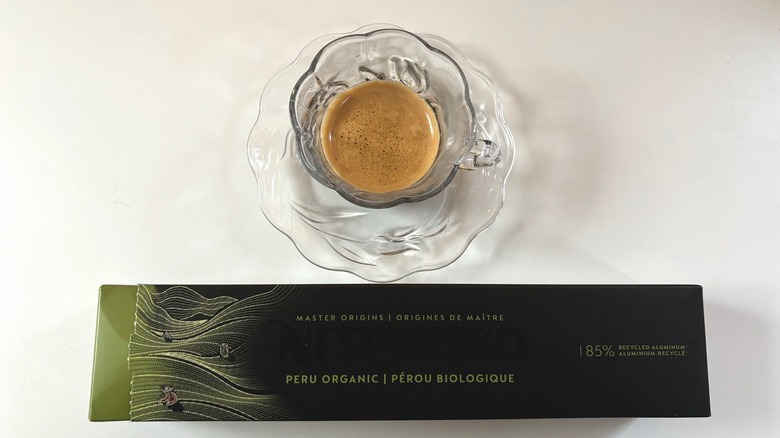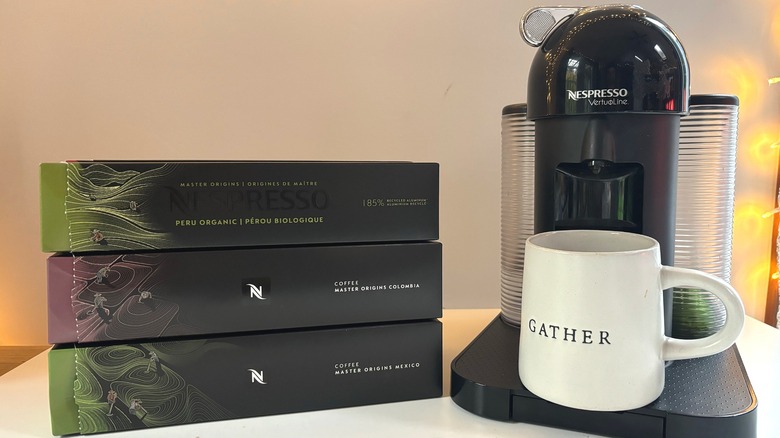Nespresso Single Origin Pods, Ranked
If you're an avid coffee drinker who owns a Nespresso machine, there's a good chance you've at least considered trying one of the company's single origin pods. Single origin coffees are, as the name implies, sourced from a single country, geographic region country, or even a single coffee farm. They offer a great way to get a sense of what specific region's coffee beans taste like. Blends, on the other hand, combine coffee beans from various regions to achieve different, balanced flavor profiles.
I'm a huge fan of single origin coffees — each one is unique, as the full character of the coffee's region is able to come through in a cup without any other beans diluting its flavor. On the flip side, because single origin coffees can be so unique, their palatability is likely to vary from person to person. Blends can account for and balance out any nuances in a specific region's bean. If you want to get a feel for what each country's coffee has to offer, it would be good to familiarize yourself with some single origin beans. As a barista with a long tenure of specialty coffee experience, I was curious to try and rank Nespresso's single origin pods based on how well each adhered to its listed tasting notes and how unique and smooth each coffee is.
6. Reviving Origins Cafecito de Puerto Rico
I'm not sure why Nespresso decided to roast its Cafecito de Puerto Rico beans as dark as it did. This is the strongest of Nespresso's Reviving Origins pods, and while I'm not mad about it, I think the company lost some of the stone fruit and citrus notes that are common in Puerto Rican coffee by roasting it this dark. Each pod brews a double espresso, and though I sipped it black, I'd definitely use it as a base for a fluffy Nespresso latte next time.
This pod is intense, with dark cocoa being the only note listed on the box of pods. I'm always wary when I see coffee beans that only have notes of chocolate and caramel listed — chocolate and caramel notes will always come through in the roasting process, and listing them is basically saying that your coffee tastes like coffee. Though dark chocolate came through strongly, I was pleased to find that I also got a good amount of nuttiness. It was slightly bitter when drank black, but I was still surprised by how smooth it was considering how dark it had been roasted. While I think this pod would make a great base for a smooth, strong latte, I don't think it would be palatable on its own to the casual coffee drinker.
5. Master Origins Mexico
I have some questions about Nespresso's Master Origins Mexico coffee. Mostly, I'm wondering why the company chose to use a double-washed Robusta bean rather than a single-washed Arabica bean. I understand double-washing a Robusta bean to help temper some of its natural, intense acidity, but I felt that the double-washed process with the Robusta bean led to a quieter cup than a single-washed Arabica might have. Maybe I'm just being picky, though — this isn't the worst Nespresso pod out there.
I'd like to know whether the beans were sourced from a more specific region in Mexico, as the country's beans vary widely depending on the altitude they're grown at. The notes of this cup were pretty smoky, with some warm spices coming through at the end. Though I didn't get any of the bright, citrus notes that I appreciate about some Mexican coffees, this cup was reminiscent of a campfire without being bitter or too woody (which would be a good thing if the pod wasn't pretty muted). This pod size brewed a whole cup, but I found myself wishing it had just brewed as a double espresso size so I could have some more flavor intensity. I think this would be a good cup for the casual drinker who doesn't love strong coffee. If you want to taste the fullness of what Mexican coffee beans have to offer, I don't think this pod is a good representation.
4. Reviving Origins Kahawa Ya Congo
As a huge, huge fan of African coffees (specifically from Rwanda, Ethiopia, and Burundi), I had higher hopes for Nespresso's Kahawa Ya Congo coffee than what it delivered. I expected a certain bright acidity to the cup, which is characteristic of coffees sourced from the volcanic soil of the Kivu region in the Democratic Republic of Congo. I definitely didn't get a bad cup of coffee, but it didn't quite have the sweet, fruity notes Nespresso claims it does. I may have been expecting too much, but regardless, this cup fell a little flat.
There was a gentle, pleasant aroma of dark stone fruit and nuts while the coffee was brewing. It was appealing but not as light or fruity as I anticipated. My first sip of this coffee, while intense, was still undeniably smooth. It was also incredibly nutty, and rather than being berry-forward like many African coffees I enjoy, berries lingered slightly at the end of each sip. I do appreciate that this cup is intense enough not to get lost if you added some milk to it (as the Mexico coffee almost certainly would). But, I don't think it's suitable as just a black coffee, and I don't think it embodies the fullness of what Congolese and Africans coffees have to offer.
3. Master Origins Colombia
I don't usually think of Colombian coffee as being particularly fruity — rather, I tend to find these brews nutty, slightly honeyed, and even a tiny bit floral. So, I was surprised when Nespresso said its Master Origins Colombia pods boasted juicy notes of bright red fruit and even compared it to wine. I suspect these beans were grown in a higher-altitude region of Colombia due to their juiciness, but again, I wish the company would be more specific about the region its single-origin beans are grown in so I could suss out the pods a bit better.
This cup was surprisingly bright. While I'm not sure I would agree that it's winey, I got the juiciness of red fruit in my first sip. The coffee sits on the sides of your tongue like a full-bodied red wine, which I enjoyed, but I could see it not being everybody's cup of tea. The sweetness of the berries lingers at the end of the sip. While this cup would hold up well to some cream, it could also be palatable as a plain, black cup. If you wanted to amp up the sweetness, add a tiny dollop of honey to sweeten this Nespresso coffee.
2. Master Origins El Salvador
I'm not intimately familiar with El Salvadorian coffee. This was relatively new to me, and I was surprised by how much I enjoyed this cup. The company went with a red honey processed bean when crafting this coffee. After learning this, it made immediate sense why I enjoyed it so much. The red honey process leaves most of the mucilage (the pulp of the coffee cherry) on the beans as they dry, leading to a greater flavor intensity after roasting. While this isn't the most fruit-forward cup I've ever had, it's one of the fruitier, sweeter Nespresso pods I've tried.
The coffee smelled jammy while it was brewing, which made me excited to try my first sip of the cup. The sip was more mellow than I anticipated and had a sweet finish, and the cup was fruit-forward and not at all bitter. It was easily drinkable black; in fact, I may not recommend this coffee if you're accustomed to drinking your morning cup with cream, as I could see it being overpowered with any additions. I wouldn't say this coffee wowed me, but I loved how smooth and fruity it was. I appreciate that the company chose to use a red honey processed bean for this Master Origins creation.
1. Master Origins Peru Organic
Finally, Nespresso's Master Origins Peru coffee was a suprising delight on this list. I didn't expect to be wowed by this tiny, espresso-sized pod, as it's definitely one of Nespresso's more intense Master Origins pods. Nevertheless, I appreciated what it offered. I suspect this was grown at a higher altitude, as many Peruvian coffees are, and I think it was a smart choice to roast it to a medium intensity to bring out the fullness of the coffee's fruity notes.
Speaking of fruit, it was apparent that this coffee would taste fruity from the second it started brewing — its aroma was juicy and fruity, making me excited to have a sip of this espresso. As I expected, it tasted sweet and fruity, though I would call it slightly intense because it's an espresso. To be honest, I wouldn't muddy this cup with more than a cortado-sized amount of milk. It's fruit-forward, and I got some plum notes. Overall, I enjoyed this juicy cup; my one complaint is that I don't think it would make the best latte because the flavors would be lost in that much milk.
Methodology
When choosing which of Nespresso's single origin pods to test, I only bought Vertuo pods to avoid any inconsistencies caused by switching between machines. I'm lucky enough to be familiar with coffees from different regions as well as different processing and roasting methods, so I took into account how Nespresso's beans were processed and roasted. I appreciate the time required in producing red honey processed beans, which leads to a more flavorful bean and contributes to why I ranked the El Salvadorian coffee as high as I did. I will always be mystified by the company's choice to use a double-washed Robusta bean for its Mexican highlight, though.
The main thing I looked for in each cup was some sense of originality particular to its region of origin. I didn't want the coffee to taste like a standard blend — I wanted to be able to tell that the plants were fertilized with volcanic soil, that the coffee endured a slow processing prior to roasting, or that it was grown at a high altitude. I ranked coffees lower when their notes were more muted or when I felt the roast didn't complement what the bean had to offer. Coffees that I ranked higher had more standout elements, like the juiciness of the Peru bean or the sweetness of the El Salvador offering.
